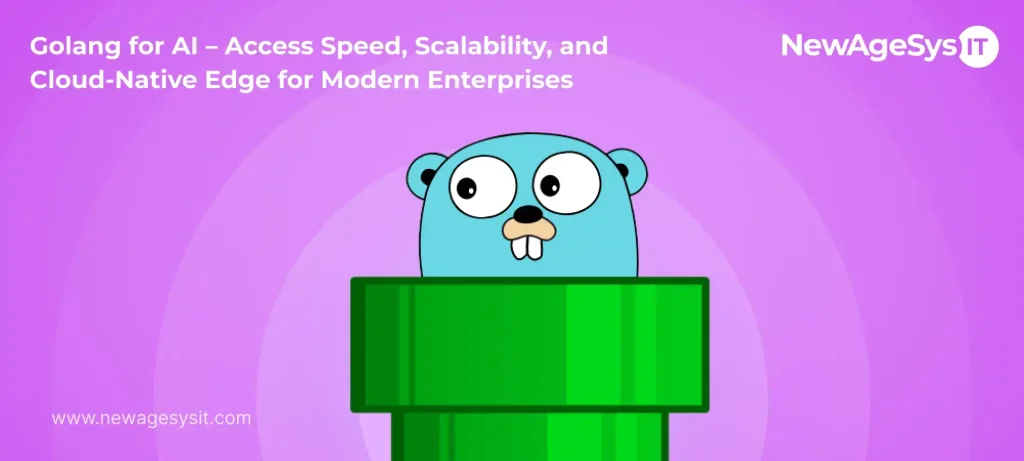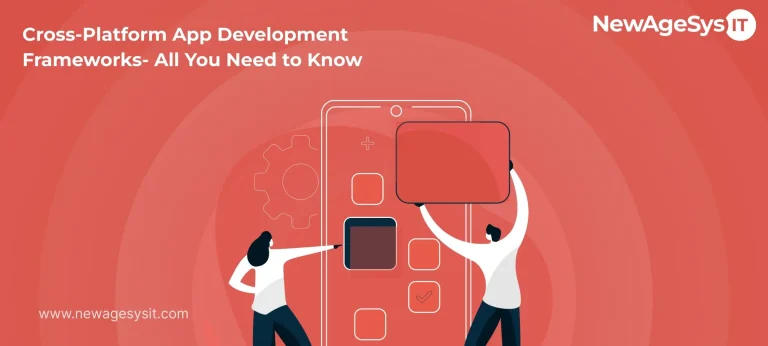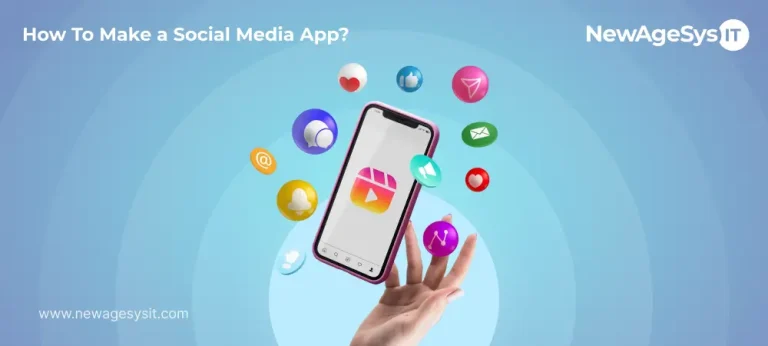| Key Takeaways: Golang’s concurrency (goroutines, channels) makes it an ideal language to develop real-time AI apps, APIs, and distributed systems. Go powers Kubernetes and Docker, which makes it perfect for deploying an AI solution that is scalable and containerized. Python still leads in libraries, with offerings like TensorFlow, PyTorch, and NLP tools, but Go’s libraries (Gorgonia, GoLearn) are growing. Post-2021, Golang for AI has gained a lot of enterprise adoption because of Genkit. Businesses can leverage dedicated Go teams, hybrid Python+Go setups, or even consulting partnerships for developing AI solutions. |
If you are a business that wants to employ Golang for your AI project, but are still skeptical, well, the article is for you.
To add, not sure if you are aware of it. But Golang was never the first choice for AI development.
The programming language was released by Google in 2009. However, it was only in 2021 when the language started to see some real adoption, especially for AI purposes. Why did the former happen, and why did the latter happen?
Well, Python already dominated the early stages when AI development was happening. While the early experiments related to Golang for AI mostly began between 2015 and 2017. Major disadvantages were fewer AI/ML libraries, a smaller community, and less beginner-friendly for AI. These are all things that empower a developer (especially a new one) or a business to invest in the language.
However, in 2021, accelerated adoption of Golang for AI development began because of its cloud-native AI, containerization (Docker/Kubernetes) capabilities, and Google’s push with Genkit.
In fact, currently, there are 5.8 million developers across the globe, actively working on Go.
So, here we have tried to cover the story of ‘Golang+AI’ and whether it has become a real fit for business ventures or not. Why trust us with the topic? Well, we have been delivering golang development services for a while now.
Therefore, let’s begin!
Why Choose Golang for AI Development?
For anyone who is well-acquainted with the history and resurgence of Golang for AI, it may be known that for most businesses, choosing Python over it was a no-brainer. In fact, to date, Python remains the widely adopted option for AI.
But why did that happen? The question largely boils down to the choice between faster mileage and better coverage. Golang was always the better option for enabling concurrency, which leads a business to scale effectively, handling tonnes of requests simultaneously as opposed to Python. However, Python offered speed and simplicity.
So what really flicked? Golang became a programming language that offered a unique blend of performance, simplicity, and scalability.
Golang (or Go) is gaining traction in AI development because of its unique blend of performance, simplicity, and scalability. While Python remains the most widely adopted language for AI, Go’s ecosystem offers advantages that make it a strong alternative for teams seeking speed and efficiency.
And, it’s not like businesses aren’t tussling between the aforementioned choices, but as we know, there are trade-offs on both sides. But, not focusing on that, it’s better to first call out the benefits associated with using Golang for AI.
Benefits of Golang for AI:
- High Performance: Compiled language and runs super close to machine speed as opposed to languages that are interpreted (Python, JavaScript, Ruby, PHP, R, etc.).
- Built-in Concurrency: Goroutines and channels allow for efficient parallel processing of AI workloads (data preprocessing, feature extraction, model training, etc.).
- Scalability: Golang is well-suited for distributed systems and handling large-scale AI applications.
- Memory Efficiency: It offers a lightweight concurrency model that helps optimize system resources.
- Stability & Reliability: It has strong typing and memory safety that reduces runtime errors during AI production cycles.
- Cross-Platform Support: It is easy to build and deploy AI solutions using Golang across different environments (Operating Systems, Cloud Platforms, Containerized Environments, On-Premise Servers, etc.).
- Integration with AI Services: Works seamlessly with APIs, cloud services, and microservices.
Cloud-Native Compatibility: As mentioned earlier, ideal for containerized AI apps (Docker, Kubernetes).
Golang vs Python for AI: Simplicity vs. Speed
As discussed, the major battle is often about Golang vs Python; however, Python is still a largely preferred option, especially if we talk about rapid prototyping. The reason, well, two: simplicity and vast ML libraries. However, as discussed, again, Go has superior runtime speed and handles concurrent tasks way more efficiently.
But this is not the entire picture, and to show that to you, here’s a table that holistically compares the two:
| Feature | Golang (Go) | Python |
|---|---|---|
| Performance | Compiled, faster execution | Interpreted, slower runtime |
| Concurrency | Native goroutines are highly efficient | Relies on multiprocessing/threading |
| Ease of Use | Simple syntax, but less AI-focused libs | Very easy, rich AI/ML ecosystem |
| Ecosystem | Growing libraries, strong standard pkg | Mature ML frameworks (TensorFlow, PyTorch, scikit-learn) |
Real-World Factors – Developer-Friendly Features
- Rich Standard Library: Networking, JSON, testing, and concurrency tools are offered out of the box.
- Cloud-Native Support: Go is the backbone of Kubernetes and Docker. So, it is a natural fit for deploying AI workloads in cloud environments.
Capabilities of Golang for AI
Be it outsourcing, creating an in-house team, or simply hiring capable freelancers, you can not effectively argue or even, let’s say, manage the team without knowing the true strength behind something. This doesn’t mean you aim to become a technical wizard, but saying speed, concurrency, and cloud won’t cut the deal.
Instead, you need to be aware of Go’s true capabilities slightly more in-depth.
Core Libraries and Toolkits
Go doesn’t have Python’s massive AI ecosystem, but it does have growing options:
- Gorgonia – Build and train neural networks.
- GoLearn – For classic ML tasks like classification and clustering.
- Fuego – Lightweight deep learning experiments.
- goml – Online machine learning.
- Wrappers – Bindings for TensorFlow, PyTorch, and C-based ML libraries.
Basically, developers can either build directly in Go or integrate with Python frameworks.
Data Processing with Go
AI starts with data, and Go shines here:
- ETL (Extraction, Transformation, and Loading) pipelines – Process large datasets quickly.
- Batch jobs – Clean, normalize, or augment data in parallel.
- Real-time streams – Handles IoT, logs, or financial transactions.
- APIs – Serve processed data at scale.
Fun Fact: Go’s concurrency model can crunch millions of records at once without lag.
NLP with Go: Strengths and Gaps
Go’s NLP capabilities are improving, but are still limited in comparison to Python.
Places Where It Works Well:
- Text preprocessing (tokenization, regex, string ops).
- High-volume chatbots and conversational APIs.
- Lightweight sentiment analysis or keyword extraction.
Limitations:
- A few advanced NLP libraries.
- Complex tasks (translation, transformers) often still need Python.
Integration with Other Ecosystems:
Go plays nicely with other tools:
- TensorFlow bindings – Run pre-trained models.
- API integration – Call PyTorch, Hugging Face, or cloud AI APIs (AWS, GCP, OpenAI).
- Hybrid approach – Train in Python, deploy in Go for scale and speed.
Use Cases of Golang for AI – Exploring What ‘Go’ Can Do!
In recent years, there’s been a reason why Golang for AI development is a much-discussed topic. To throw light on that, here are some of its core use cases, to even help you understand what the language can do for you in real-world scenarios.
Core AI Use Cases:
| Use Case | Why Go is a Fit | Example Scenarios |
|---|---|---|
| AI-driven Chatbots & Assistants | Goroutines handle thousands of conversations at once with minimal delay. | Customer support bots, virtual banking assistants, and healthcare triage bots |
| Real-Time Recommendation Systems | Processes user data in parallel to generate instant results with personalized suggestions. | E-commerce product recommendations, streaming movie/music suggestions |
| Edge AI & IoT | Lightweight binaries run efficiently on devices with limited resources. | Smart home devices, industrial IoT sensors, and real-time monitoring cameras |
Real-World Adoption:
| Company / Project | How Go Fits into AI Workloads |
|---|---|
| Uber | Uses Go in its ML platform for real-time geospatial data and matching drivers with riders. |
| Dropbox | Migrated performance-heavy workloads like file sync intelligence to Go for faster processing. |
| Kubernetes (built in Go) | While not AI itself, it powers large-scale deployment of AI/ML workloads in cloud environments. |
| Tencent & ByteDance | Rely on Go to run high-concurrency platforms that serve AI-driven recommendations and content feeds. |
Challenges & Limitations of Golang for AI
Well, we have already talked about Golang AI development in length, which mostly includes its strengths and capabilities. However, now, it is time to assess the limitations of the language. So, let’s begin:
1. Limited Libraries
- Fewer AI/ML libraries compared to Python.
- Advanced deep learning or NLP often requires custom solutions or Python integration.
2. Smaller Developer Community
- Less AI-focused support, tutorials, and open-source projects.
3. Integration Hurdles
- Connecting with frameworks like TensorFlow or PyTorch may still need APIs or microservices.
- Some enterprise tools lack native Go support.
Our Takeaway: Go is an excellent option if you are looking to build AI with Golang that is high-performance and scalable. However, Python would be a better option for rapid prototyping or advanced ML tasks.
Future of Golang in AI
‘Golang for AI development’ is a rapidly evolving field with significant developments that are able to deliver business-ready solutions. Here’s an overview of those key advancements:
🔧 Genkit for Go: Google’s AI Framework
Google introduced Genkit for Go, which is a stable, production-ready framework designed to simplify the development of AI-powered applications. Some of its key features include:
- Type-safe AI workflows using Go structs and JSON schema validation.
- Unified model interface that supports Google AI, Vertex AI, OpenAI, Ollama, and more.
- Tool calling, RAG, and multimodal support for advanced AI functionalities.
- Rich local development tools that include a standalone CLI binary and Developer UI.
- AI coding assistant integration via the genkit init:ai-tools command for tools like the Gemini CLI.
Each of these functionalities of the framework has been covered in a Google Developers Blog that announced GenKit Go 1.0.
🌐 Community Growth: Awesome Golang AI
The Awesome Go AI repository on GitHub is a collection of tools and libraries that can be used for developing Go with AI integration. This includes:
- Go OpenAI library for integrating OpenAI APIs.
- Go SDK for Google Generative AI enables developers to use Google’s state-of-the-art generative AI models.
- LangChain Go is the Go language implementation of LangChain.
- Tiktoken Go, a fast BPE tokenizer for use with OpenAI’s models.
- Go Tesseract, a Golang OCR package using the Tesseract C++ library.
This growing collection is the reflection of the increasing interest and support for the language, especially factoring in AI development within the Go community.
☁️ Golang’s Role in Cloud-Native AI
Golang’s inherent characteristics make it a strong candidate for cloud-native AI applications, including:
- Performance and scalability which is suitable for building scalable machine learning pipelines.
- Integration with AI/ML workflows, facilitating the development of scalable systems.
- Alignment with cloud-native principles, including ease of learning, seamless operation in containers, and close integration with popular tools.
Each of these attributes positions Go as a valuable language that can be used to develop enterprise-grade AI solutions in cloud environments.
Building AI with Golang – Steps, Routes, and A Little About NewAgeSys
Well, we are primarily an outsourcing company, and this is an article that helps businesses with Golang for AI app development or in general building AI with Golang. Therefore, we’d assume that by now, you may be looking for a few steps that can help build your solution, routes that you can take for it, and we have also added a little bit about ourselves.
So, let’s explore this section.
Steps to Begin with Golang for AI App Development
Know this, that the steps mentioned below are not exactly one-size-fits-all. However, they can definitely work as a general guideline for you to realize your project. Why do we say this? Because these are the culmination of the hard work we’ve put in to help our clients.
Now, let’s begin!
- Define Business Goals
First, begin by gaining clarity on the different use cases of Golang for AI that you would like to implement. We have already discussed a few examples earlier, and just to refresh, here they are: chatbots, recommendations, predictive analytics, etc.
Align the outcome devised with the business KPIs, i.e., faster response time, high personalization, cost savings, etc.
- Choose the Right Stack
Now, start factoring in all the core Go libraries, like Gorgonia, GoLearn, goml, etc., that may help you achieve the business outcome. Since most solutions around the world use Python, make sure to assess Python interoperability for that added flexibility.
A few places to check would be TensorFlow/PyTorch bindings, API integrations, etc.
- Build Data Infrastructure First
Set up ETL (Extraction, Transformation, and Loading) pipelines for Golang data processing, and use concurrency to handle real-time streams or any large batch jobs, as per requirement.
- Prototype and Validate
At this stage, we recommend that you begin with small-scale models and leverage the fast compilation and deployment cycle of Go to test rapidly.
- Deploy in Cloud-Native Environments
Use Go’s seamless fit with Docker, Kubernetes, and Serverless platforms for scaling your solution. And, ensure that there is cross-platform support, i.e., on-premises, hybrid, and multi-cloud.
Outsourcing Opportunities with Golang AI Development
If you don’t have an in-house team with Go expertise, worry not; there are several smart routes you can take. These routes, in effect, will be more affordable as compared to forming and training your own team, and efficient because these options have ideally worked on multiple Go projects in the past.
So, here are those smart outsourcing options:
| Outsourcing Route | Why It Helps | Example Scenarios |
|---|---|---|
| Dedicated Go AI Teams | Access to specialists in Go + AI libraries | Building custom ML models, SaaS products |
| Hybrid Teams | Combine Python AI engineers with Go developers | Python model training + Go deployment |
| Consulting Partnerships | Strategic alignment with experts in AI scaling | Enterprises exploring AI-driven automation |
Now, let’s assess the cost of each of these outsourcing routes.
Cost of Outsourcing Routes in Different Regions
1. Dedicated Go AI Teams
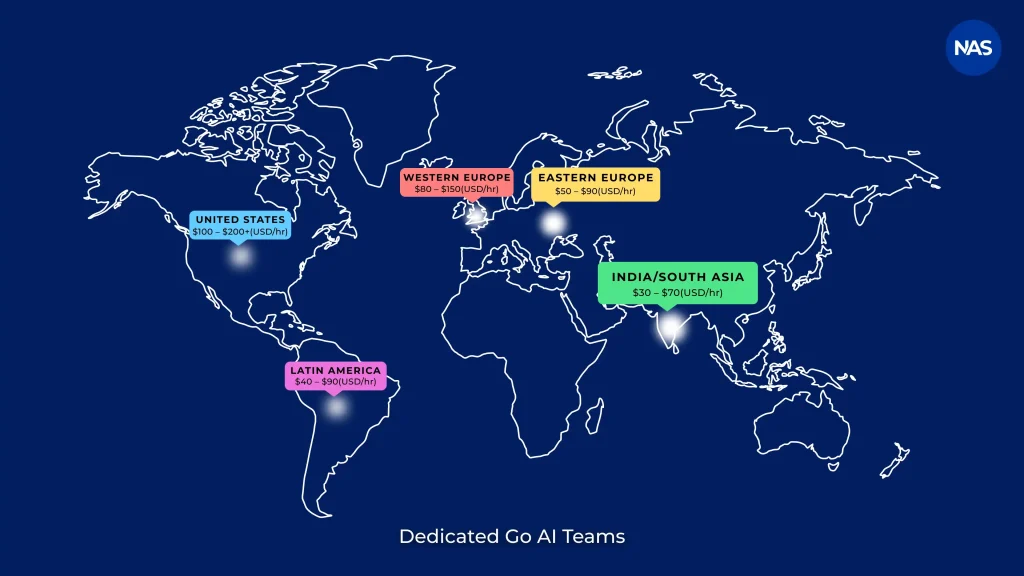
| Region | Estimated Rate (USD/hr) | Notes / What You Get |
|---|---|---|
| United States | $100 – $200+ | Senior/full-time; deep Go + AI/ML expertise, full ownership |
| Western Europe | $80 – $150 | Strong skills, compliance, and higher costs of living |
| Eastern Europe | $50 – $90 | Good skill, cost-effective, strong technical talent |
| India / South Asia | $30 – $70 | Mid/senior Go + some AI; lower overhead |
| Latin America | $40 – $90 | Similar to Eastern Europe, depending on the country |
2. Hybrid Teams (Go + Python AI Engineers)
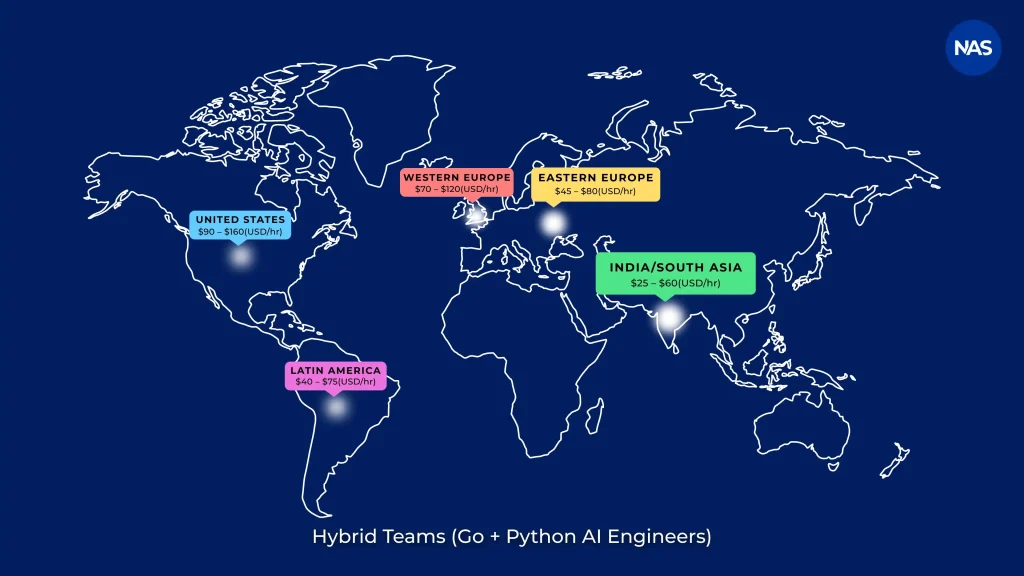
| Region | Estimated Rate (USD/hr) | Notes / What You Get |
|---|---|---|
| United States | $90 – $160 | Python + Go mix; combined skill, slightly higher cost |
| Western Europe | $70 – $120 | Balanced mix; good quality, strong compliance |
| Eastern Europe | $45 – $80 | Cost savings; good for deployment stages |
| India / South Asia | $25 – $60 | Lower cost; effective if managed well |
| Latin America | $40 – $75 | Time zone advantages, moderate rates |
3. Consulting Partnerships
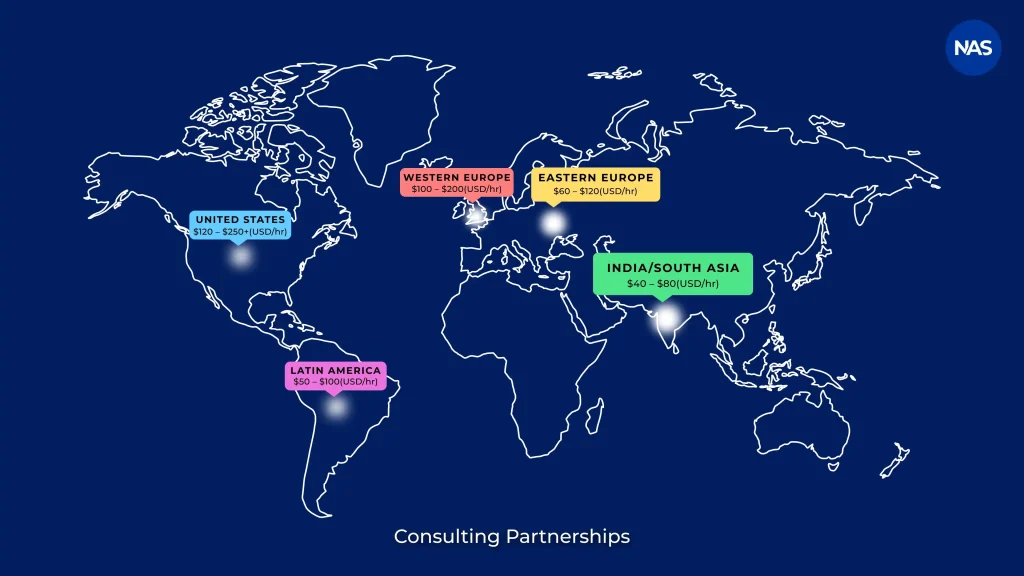
| Region | Estimated Rate (USD/hr) | Notes / What You Get |
|---|---|---|
| United States | $120 – $250+ | High-level strategy, architecture, expert consulting |
| Western Europe | $100 – $200 | Senior consulting; specialization costs |
| Eastern Europe | $60 – $120 | Good value consultancy; less costly than US/WE |
| India / South Asia | $40 – $80 | Lower overhead; good for long-term consulting |
| Latin America | $50 – $100 | Moderate rates; solid for cross-border projects |
Aligning Budget, Talent, and Use Cases – A Few Notes
- Budget → Decide early if you will optimize for cost (outsourcing) or control (in-house).
- Talent → Go AI talent is growing, but the pool is smaller than Python. Hybrid hiring models might work best.
Use Cases → Not all AI apps need Go. Use it when concurrency, scale, or cloud-native deployment are your top priorities.
A Little About NewAgeSys
Now, if the details above may have frightened you a bit or none, still, we are NewAgeSys. We have over 25+ years of experience delivering outsourcing solutions. And, Golang is one of our strongest fits.
We can offer you full-fledged end-to-end support, create a hybrid plan, or simply deliver you the desired consultation, whichever you prefer.
At NewAgeSys, our aim is to cover the journey with our clients and help them realize the final product that they intended for their business goals. Till now, we have worked with startups, SMEs, and enterprises. And, our area of expertise covers multiple industries like healthcare, entertainment, dating, transportation, SaaS, etc.
So, if you want to hire Golang developers to help you with building AI with Golang, we might be able to fill that need. And, if you are thinking of affordability and work ethic. Well, we deliver prices between $25-$49 per hour, depending upon the complexity of the project. Also, we are based out of the U.S., so we carry the work ethic of a U.S.-based company.
If you are thinking, How are we able to deliver such incredible prices despite being a U.S.-based company? Well, we have offshore development centers that give us access to a diverse talent pool. A talent pool that is capable of turning the impossible into the possible.

End Note
Now, to summarize our thoughts here! – Is Golang the true way to go about things? I think we believe we have answered this to the best of our capabilities, i.e., when you are in need of high concurrency, performance, and simplicity. As an outsourcing company, we welcome clients to choose their bid. And, likewise, Python is also an incredible programming language.
However, the real answer will only come when you sit with your team and your idea, and you will dissect things to gather your real requirements. As your requirements surface, the clarity between whether you need Python or Golang is gonna diminish.
Stating this, we hope we may have helped you with some bit of knowledge. And, if you believe in our credibility, as we have shared in the article, we’ll be waiting for you to connect with us.
FAQs:
Q1. Is Golang good for AI?
A big yes, but there are some caveats to it. For instance, if your AI development requirements revolve around performance-heavy tasks, concurrency, scalability, data processing pipelines, etc., Golang is the way to go.
However, if your focus is primarily on AI/ML libraries, developing advanced NLP models, or community support (which isn’t big enough in comparison to other languages), then you should try Python.
Q2. How does Golang handle data processing for AI?
Golang actually has a very strong hand in data processing for AI despite not having as many ML libraries as Python.
Here’s how it handles data processing:
- Concurrency with Goroutines is capable of millions of records in parallel without lag.
- ETL (Extract, Transform, Load) functionality of Go is capable of building pipelines that clean, normalize, and aggregate huge datasets.
- Go’s channel and its lightweight threads make it a natural fit for streaming AI data for use cases like recommendation engines, fraud detection, etc.
- Go excels at exposing processed datasets using fast and scalable APIs.
- Its lightweight concurrency models avoid any excessive memory overhead while working on large workloads.
Q3. Can I use Golang for Natural Language Processing (NLP)?
Yes, Golang for natural language processing is a real thing. However, there are a few trade-offs.
Let’s first discuss how Golang fits in the NLP context:
- Text Preprocessing (Tokenization, stemming, stop-word removal, etc.) is Go’s strong suit.
- Rule-based & Classical NLP (Works well with keyword extraction, regex-based entity recognition, and sentiment analysis for small to mid-size datasets).
- Deep Learning-based NLP (Much weaker in comparison to Python; projects like Spago (for pure ML and deep learning implementation) are bridging gaps).
- Serving NLP Models ( You can train models using Python and then make them serve in Go using ONNX runtime bindings, TensorFlow Go bindings, etc.)
A few key trade-offs are: limited ecosystem, fewer pre-trained models, and inability to pull off heavier deep learning tasks.
Q4. Golang vs Python for AI: which one should I choose?
Below, we have provided a holistic list for both languages and scenarios where they can be considered:
Choose Python if:
- You’re looking for rich AI/ML libraries (TensorFlow, PyTorch, Hugging Face, Scikit-learn).
- You’re in your research, prototyping, or training models phase.
- You want access to a huge AI developer community and pre-trained models.
- Your project relies on deep learning or NLP at scale.
- Time-to-market for AI experimentation is more important for you than raw performance.
Choose Golang if:
- You require fast and concurrent AI services (APIs, chatbots, recommendation engines).
- Your priority is scalable deployment across cloud or microservices.
- You want low-latency inference (e.g., real-time fraud detection, IoT).
- You’re building production systems where both performance + stability matter more than prototyping speed.
You plan a hybrid workflow → Python for model training, Go for deployment.
Q5. What are the advantages of using Golang over Python for AI?
Here are the direct advantages you get over Python, if Golang is chosen for AI:
- Faster execution because of its compiled nature.
- Goroutines and channels make parallel data processing efficient.
- It is better suited to large and distributed AI applications.
- Lightweight binaries without heavy dependencies.
- Strong typing and simple debugging reduce runtime errors.
- Go powers Kubernetes & Docker.
Q6. Does Golang have enough libraries for AI app development?
Not yet, and it is one of the primary limitations of the programming language.
What does it have?:
- Gorgonia
- GoLearn
- Goml
- Fuego
- Gonum
What doesn’t it have?
- Rich libraries like TensorFlow, PyTorch, Hugging Face, etc.
- Pre-trained models, NLP toolkits, and advanced vision libraries.
- Massive community support and tutorials.
Q7. What are some alternatives to Golang for AI?
Here is the list of alternatives that you can consider instead of Golang for AI:
- Rust – It is faster, memory-safe, and offers zero-cost abstractions. However, its ecosystem is smaller and the learning curve is steeper.
- C++ – Blazing fast and has mature ML libs. But the complex syntax, harder debugging, and less developer productivity are some of its issues.
- Java – Enterprise-ready, delivers JVM scalability, and offers AI libs like DL4J. On the flipside, the runtime is heavier, slower in comparison, and less efficient in terms of concurrency.
- Scala – Excellent for big data, functional + object-oriented. However, it lacks because it is verbose, compile times are slow, and fewer lightweight AI tools.
- Julia – It is built for scientific computing & ML + easy math syntax. But the ecosystem is younger, with weaker concurrency and deployment tooling.
- Node.js – Great for web/real-time AI, and has a huge JS ecosystem. On the contrary, it is weak for heavy ML, slower runtime, and limited concurrency compared to Go.
And, if ‘Why Go?’ as a question still bothers you, then Golang delivers simplicity, concurrency, and cloud-native deployment.
Q8. List out a few Golang AI real-world examples.
Here is a list of a few Golang AI real-world examples, have a look:
- Uber – It’s a real-time ML platform that is used for fetching geospatial data and driver-rider matching.
- Dropbox – Uses the tech for handling performance-heavy workloads like file sync intelligence.
- Kubernetes – Powers large-scale deployment of AI/ML workloads (cloud-native AI infrastructure).
- Tencent – High-concurrency platforms for AI-driven recommendations and content feeds.
- ByteDance (TikTok) – It’s real-time AI content recommendations at a massive scale.
Q9. Are there third-party Golang tools for AI development?
Yes, there are several third-party tools that support Golang for AI development. Below, we have mentioned options in different categories:
Core AI & ML Libraries:
- Gorgonia
- GoLearn
- goml
- Fuego
Data Processing & Utilities:
- gonum
- golearn/etl
NLP & Text:
- prose
- go-tesseract
AI Integration / Wrappers:
- TensorFlow Go
- gopy / GoPyTorch bindings
- Go OpenAI
Q10. Do small-scale companies need to adopt Golang for their projects?
Not necessarily. However, there are certain spaces where small-scale companies can take the help of Golang for their projects. For example:
- Need for High Concurrency – Real-time chatbots, recommendation engines, multiplayer apps, etc.
- Cloud-native Deployments – If you are using Docker/Kubernetes from the beginning.
- Performance-sensitive Workloads – Low-latency AI microservices or edge AI.

